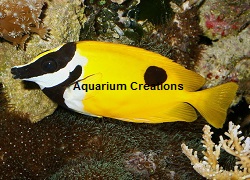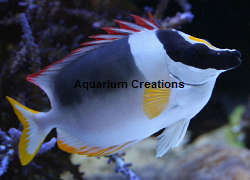
|
|
|
|
|
|
|
|
|
|
Foxface Rabbitfish
|
The Foxface rabbitfish are found in shallow lagoons in the tropical Western Pacific. They will make a great addition to an appropriately sized aquarium. They are colorful, have small hare-like mouths, large dark eyes, a very peaceful temperament, and are easy to care for. They also have well developed, venomous dorsal and anal fin spines. Use caution when handling as the spines will inflict a painful sting. They also are excellent algae-eaters, and are typically much hardier than the ever-popular surgeonfish. Foxface rabbitfish have the ability to camouflage themselves as another means of staying alive. All of them can dramatically change their appearance at will, and typically do so when sleeping or when frightened. Regardless of their "normal" overall coloration, which is often quite bright, they can lose it and take on a splotchy appearance that's not colorful at all and often looks more like military camouflage. When hiding out, especially in rockwork and in the branches of corals, these patterns can be very effective and do quite a good job of making the fishes more difficult to see. So, don't automatically be alarmed if you use a flashlight to look in your aquarium when the lights are off (like I do regularly) and can't seem to find your fish. Foxface rabbitfish are omnivorous, eating mostly algae and zooplankton. From time-to-time, if hungry, it may nip at corals, such as Zoantharia (zoanthids and button polyps). Though not an obligate herbivore, the foxface rabbitfish does require algae in its diet. In captivity, it can usually be coaxed into eating a combination of mysis shrimp, sheets of dried seaweed, and marine flake food or pellet food containing algae. It is popular with aquarists due to its appetite for many macroalgae that commonly overgrow the rockwork in the home aquaria. Foxface Rabbitfish are highly skilled at removing this algae and will generally clear an aquarium of it within a matter of days. |
 Click to view You Tube Video on the One Spot Foxface
Small Reg. $99.99 On Sale $79.99 Medium Reg. $119.99 On Sale $89.99 Large $149.99 XLarge $199.99 |
Siganus vulpinus  YouTube Video of the Foxface Lo
YouTube Video of the Foxface Lo
Small $89.00 Medium $99.00 Large $179.00 XLarge $259.00 |
Siganus magnificus  Click to view You Tube Video on the Magnificent Foxface
Small $209.99 Medium $239.99 Large $269.99 XLarge $329.99 |

Small $99.99 Small/Medium 114.99 Medium $144.99 Medium/Large $189.99 Large $299.99 |
|
Copyright 2020 Aquarium Creations Online - Photos are representative of each species. All marine life will be unique and variations should be expected, color and sizes may vary. |